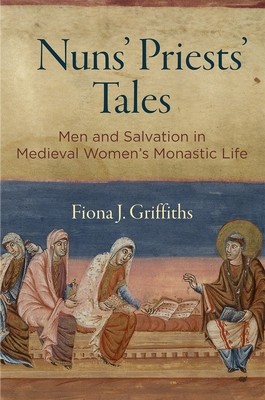
- We will send in 10–14 business days.
- Author: Fiona J Griffiths
- Publisher: University of Pennsylvania Press
- ISBN-10: 0812249755
- ISBN-13: 9780812249750
- Format: 15.5 x 23.4 x 3.3 cm, hardcover
- Language: English
- SAVE -10% with code: EXTRA
Reviews
Description
During the Middle Ages, female monasteries relied on priests to provide for their spiritual care, chiefly to celebrate Mass in their chapels but also to hear the confessions of their nuns and give last rites to their sick and dying. These men were essential to the flourishing of female monasticism during the eleventh and twelfth centuries, yet they rarely appear in scholarly accounts of the period. Medieval sources are hardly more forthcoming. Although medieval churchmen consistently acknowledged the necessity of male spiritual supervision in female monasteries, they also warned against the dangers to men of association with women. Nuns' Priests' Tales investigates gendered spiritual hierarchies from the perspective of nuns' priests--ordained men (often local monks) who served the spiritual needs of monastic women.
Celibacy, misogyny, and the presumption of men's withdrawal from women within the religious life have often been seen as markers of male spirituality during the period of church reform. Yet, as Fiona J. Griffiths illustrates, men's support and care for religious women could be central to male spirituality and pious practice. Nuns' priests frequently turned to women for prayer and intercession, viewing women's prayers as superior to their own, since they were the prayers of Christ's brides. Casting nuns as the brides of Christ and adopting for themselves the role of paranymphus (bridesman, or friend of the bridegroom), these men constructed a triangular spiritual relationship in which service to nuns was part of their dedication to Christ. Focusing on men's spiritual ideas about women and their spiritual service to them, Nuns' Priests' Tales reveals a clerical counter-discourse in which spiritual care for women was depicted as a holy service and an act of devotion and obedience to Christ.EXTRA 10 % discount with code: EXTRA
The promotion ends in 18d.02:46:15
The discount code is valid when purchasing from 10 €. Discounts do not stack.
- Author: Fiona J Griffiths
- Publisher: University of Pennsylvania Press
- ISBN-10: 0812249755
- ISBN-13: 9780812249750
- Format: 15.5 x 23.4 x 3.3 cm, hardcover
- Language: English English
During the Middle Ages, female monasteries relied on priests to provide for their spiritual care, chiefly to celebrate Mass in their chapels but also to hear the confessions of their nuns and give last rites to their sick and dying. These men were essential to the flourishing of female monasticism during the eleventh and twelfth centuries, yet they rarely appear in scholarly accounts of the period. Medieval sources are hardly more forthcoming. Although medieval churchmen consistently acknowledged the necessity of male spiritual supervision in female monasteries, they also warned against the dangers to men of association with women. Nuns' Priests' Tales investigates gendered spiritual hierarchies from the perspective of nuns' priests--ordained men (often local monks) who served the spiritual needs of monastic women.
Celibacy, misogyny, and the presumption of men's withdrawal from women within the religious life have often been seen as markers of male spirituality during the period of church reform. Yet, as Fiona J. Griffiths illustrates, men's support and care for religious women could be central to male spirituality and pious practice. Nuns' priests frequently turned to women for prayer and intercession, viewing women's prayers as superior to their own, since they were the prayers of Christ's brides. Casting nuns as the brides of Christ and adopting for themselves the role of paranymphus (bridesman, or friend of the bridegroom), these men constructed a triangular spiritual relationship in which service to nuns was part of their dedication to Christ. Focusing on men's spiritual ideas about women and their spiritual service to them, Nuns' Priests' Tales reveals a clerical counter-discourse in which spiritual care for women was depicted as a holy service and an act of devotion and obedience to Christ.

Reviews